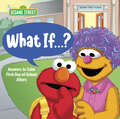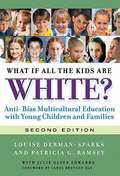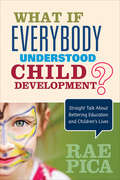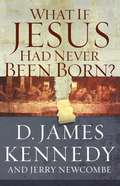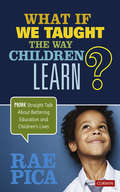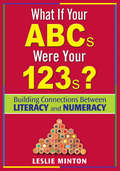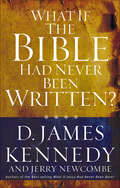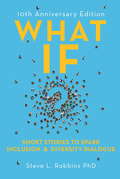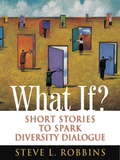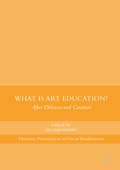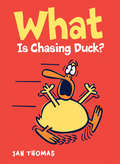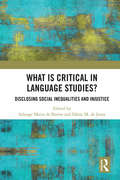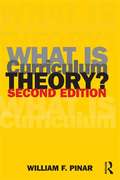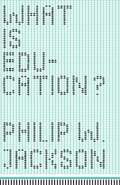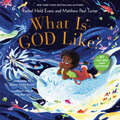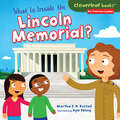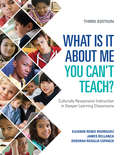- Table View
- List View
What If . . . ? (Sesame Street): Answers to Calm First-Day-of-School Jitters
by Sonali FryElmo and his Sesame Street friends help ease anxiety about starting preschool and kindergarten with this picture book that straightforwardly answers children's "What if...?" questions.Young children can have lots of anxiety, especially when faced with something new, such as starting school. Luckily, Elmo and his Sesame Street friends are here to relieve those first-time jitters! This picture book helpfully answers common questions (What if I don't like my teacher? What if I don't know where the bathroom is?) to ease your little one's worries. Plus, the friendly, colorful faces of Elmo, Abby Cadabby, Cookie Monster, and other Muppets always produce smiles! This is a great resource--and gift--for any child about to start preschool or kindergarten.Sesame Workshop, the nonprofit educational organization behind Sesame Street, aims to help kids grow smarter, stronger, and kinder through its many unique domestic and international initiatives. These projects cover a wide array of topics for families around the world.
What If All the Kids Are White?: Anti-Bias Multicultural Education with Young Children and Families (Early Childhood Education Series)
by Barbara Sprung Louise Derman-Sparks Patricia Ramsey Brunson Carol Julie Edwards Carol Day Sharon RyanIn this updated edition, two distinguished early childhood educators tackle the crucial topic of what White children need and gain from anti-bias and multicultural education. The authors propose seven learning themes to help young White children resist messages of racism and build identity and skills for thriving in a country and world filled with diverse ways of being. This compelling text includes teaching strategies for early childhood settings, activities for families and staff, reflection questions, a record of 20th- and 21st-century White anti-racism activists, and organizational and website resources.
What If Everybody Understood Child Development?: Straight Talk About Bettering Education and Children's Lives
by Rae PicaUnderstand the connection between how kids grow and how they learn After 35 years as an education consultant, Rae Pica knows the importance of understanding the natural course of child development. In this collection, she keeps kids front and center as she provides thought-provoking commentary and actionable insights on topics such as the Common Core, the self-esteem movement, and standardized testing. Sure to inspire discussion, this pocket-size powerhouse of educational philosophy includes 29 short essays on topics critical to best practice in child development and education Opinions of experts supported by research and anecdotal evidence Real-life stories shared by teachers and parents References to related articles and interviews with experts
What If Everybody Understood Child Development?: Straight Talk About Bettering Education and Children's Lives
by Rae PicaUnderstand the connection between how kids grow and how they learn After 35 years as an education consultant, Rae Pica knows the importance of understanding the natural course of child development. In this collection, she keeps kids front and center as she provides thought-provoking commentary and actionable insights on topics such as the Common Core, the self-esteem movement, and standardized testing. Sure to inspire discussion, this pocket-size powerhouse of educational philosophy includes 29 short essays on topics critical to best practice in child development and education Opinions of experts supported by research and anecdotal evidence Real-life stories shared by teachers and parents References to related articles and interviews with experts
What If Jesus Had Never Been Born?
by D. James Kennedy Jerry NewcombeThis brilliant book asks What's right with our world? And how did it get that way? The answers may surprise you, intrigue you and inspire you. Hopefully they will change you as they have changed the world. In a day when many professing Christians appear blissfully unaware of their cultural mandate, the authors remind us that the Church is to bear the glory of God in every sphere of life.
What If There Were No Significance Tests?: Classic Edition (Multivariate Applications Series)
by Lisa L. Harlow Stanley A. Mulaik James H. SteigerThe classic edition of What If There Were No Significance Tests? highlights current statistical inference practices. Four areas are featured as essential for making inferences: sound judgment, meaningful research questions, relevant design, and assessing fit in multiple ways. Other options (data visualization, replication or meta-analysis), other features (mediation, moderation, multiple levels or classes), and other approaches (Bayesian analysis, simulation, data mining, qualitative inquiry) are also suggested. The Classic Edition’s new Introduction demonstrates the ongoing relevance of the topic and the charge to move away from an exclusive focus on NHST, along with new methods to help make significance testing more accessible to a wider body of researchers to improve our ability to make more accurate statistical inferences. Part 1 presents an overview of significance testing issues. The next part discusses the debate in which significance testing should be rejected or retained. The third part outlines various methods that may supplement significance testing procedures. Part 4 discusses Bayesian approaches and methods and the use of confidence intervals versus significance tests. The book concludes with philosophy of science perspectives. Rather than providing definitive prescriptions, the chapters are largely suggestive of general issues, concerns, and application guidelines. The editors allow readers to choose the best way to conduct hypothesis testing in their respective fields. For anyone doing research in the social sciences, this book is bound to become "must" reading. Ideal for use as a supplement for graduate courses in statistics or quantitative analysis taught in psychology, education, business, nursing, medicine, and the social sciences, the book also benefits independent researchers in the behavioral and social sciences and those who teach statistics.
What If We Taught the Way Children Learn?: More Straight Talk About Bettering Education and Children's Lives
by Rae PicaStrengthen the connection between child development and learning To help students experience joy and discovery, while also preparing them for future schooling, we need to understand the connection between how they develop and how they learn. Pica brings decades of experience in education to advocate for this change. Written as a follow-up to the bestselling What If Everybody Understood Child Development?, this book includes: · 31 easy-to-read chapters on topics including disruptive behavior, creativity, self-regulation, screen time, and mental health · Suggested next steps and resources in every chapter · Real-life examples from the author's and others&’ experiences · Evidence from brain science research · Easy-to-read format perfect for PLCs, book studies, and parents
What If We Taught the Way Children Learn?: More Straight Talk About Bettering Education and Children's Lives
by Rae PicaStrengthen the connection between child development and learning To help students experience joy and discovery, while also preparing them for future schooling, we need to understand the connection between how they develop and how they learn. Pica brings decades of experience in education to advocate for this change. Written as a follow-up to the bestselling What If Everybody Understood Child Development?, this book includes: · 31 easy-to-read chapters on topics including disruptive behavior, creativity, self-regulation, screen time, and mental health · Suggested next steps and resources in every chapter · Real-life examples from the author's and others&’ experiences · Evidence from brain science research · Easy-to-read format perfect for PLCs, book studies, and parents
What If Your ABCs Were Your 123s?: Building Connections Between Literacy and Numeracy
by Leslie G. MintonIncludes teaching scenarios modeling the crossover of literacy and math strategies, and provides techniques to strengthen students' grasp of foundational concepts and advance their skills in reasoning and problem solving.
What If the Bible Had Never Been Written?
by D. James Kennedy Jerry NewcombeBut the Bible, more than any other book, is also the most maligned on the market. Many of the cities of our culture dismiss the Word of God. In What If the Bible Had Never Been Written?, D. James Kennedy and Jerry Newcombe show that this collection of books was indeed the inspiration for almost all of the great explorers, scientists, writers, artists, politicians, and educators the world has ever known. That such a book, which has influenced so many and stood the test of time for so long, is dismissed as folklore or myth, just goes to show what extremes nonbelievers will go to rationalize their behavior.From the Ten Commandments, which many of our laws and government are based upon, to the Golden Rule, a verse taken straight out of the New Testament, to many of today's most common phrases and expressions...there is no doubt as to the influence the Bible has on everyone, in some degree, every day. What If the Bible Had Never Been Written? provides a well-documented and in-depth look at the impact the Book of Books has had on humanity, pointing to specific areas in today's society that would not be as they are now, if it were not for the Bible.
What If?: Short Stories to Spark Diversity Dialogue
by Steve L. RobbinsFrom incomparable storyteller and beloved diversity and inclusion expert, Steve L. Robbins, comes the 10th Anniversary Edition of his classic book used by scores of companies globally for diversity training.This 10th anniversary edition of the beloved classic features 10 new stories written by Dr. Robbins that help readers gain deeper insight into the role our brains play in shaping our thoughts and actions, and what we can do to be more curious and open-minded in our diverse world. Based on his study of the fields of behavioural science and cognitive neuroscience, Robbins explores unconscious bias in many of its forms, including; availability bias, confirmation bias, anchoring bias and others. What If? is a fun, unpretentious guide for individuals and organizations that will help break down defenses and shine a helpful light on human behaviour in a world filled with differences.
What If?: Short Stories to Spark Diversity Dialogue
by Steve L. RobbinsWhen Steve Long-Nguyen Robbins was growing up, his mother routinely told him, "Long, you walk on a path cleared by others, so it is your responsibility to clear the path for others." Her insightful guidance and self-sacrificing example are the forces that drive Robbins's corporate work around diversity and inclusion today. His goal is unwavering: to clear the path for others and recruit more "path makers" - to honor his mother and to make a better world for everyone. In What If?, Robbins provides twenty-six inspiring, lively, and sometimes deeply personal stories illustrating diversity and inclusion concepts. He offers insight and practical advice on how to reconcile unity with diversity and reframe our organizations for competitive advantages. He adds tips and suggestions for putting keylearning into action in your organization, ending each chapter with questions, an activity, and an assignment to inspire you to be more open-minded and inclusive and to discover how the ideas presented in the book might apply to your daily life at work and at home.
What Inclusive Instructors Do: Principles and Practices for Excellence in College Teaching
by Tracie Marcella Addy Derek Dube Khadijah A. Mitchell Mallory SoRelleInclusive instruction is teaching that recognizes and affirms a student's social identity as an important influence on teaching and learning processes, and that works to create an environment in which students are able to learn from the course, their peers, and the teacher while still being their authentic selves. It works to disrupt traditional notions of who succeeds in the classroom and the systemic inequities inherent in traditional educational practices.—Full-time Academic Professional, Doctorate-granting University, EducationThis book uniquely offers the distilled wisdom of scores of instructors across ranks, disciplines and institution types, whose contributions are organized into a thematic framework that progressively introduces the reader to the key dispositions, principles and practices for creating the inclusive classroom environments (in person and online) that will help their students succeed. The authors asked the hundreds of instructors whom they surveyed as part of a national study to define what inclusive teaching meant to them and what inclusive teaching approaches they implemented in their courses. The instructors’ voices ring loudly as the authors draw on their responses, building on their experiences and expertise to frame the conversation about what inclusive teachers do. The authors in addition describe their own insights and practices, integrating and discussing current literature relevant to inclusive teaching to ensure a research-supported approach.Inclusive teaching is no longer an option but a vital teaching competency as our classrooms fill with racially diverse, first generation, and low income and working class students who need a sense of belonging and recognition to thrive and contribute to the construction of knowledge.The book unfolds as an informal journey that allows the reader to see into other teachers’ practices. With questions for reflection embedded throughout the book, the authors provide the reader with an inviting and thoughtful guide to develop their own inclusive teaching practices.By utilizing the concepts and principles in this book readers will be able to take steps to transform their courses into spaces that are equitable and welcoming, and adopt practical strategies to address the various inclusion issues that can arise.The book will also appeal to educational developers and staff who support instructors in their inclusive teaching efforts. It should find a place in reflective workshops, book clubs and learning communities exploring this important topic.
What Is Art Education?: After Deleuze and Guattari (Education, Psychoanalysis, and Social Transformation)
by Jan JagodzinskiThis edited book gathers seven established art educators-educator artists who address art education from the philosophical position of Deleuze and Guattari. This book raises questions as to where the future of art and its education might be heading if the focus on art was to be repositioned along Deleuze and Guattari’s philosophy of immanence. The chapters are speculative as they query what is ‘thinking’ in the art process. There is an attempt to project other forms of what art can ‘do,’ and the curriculum that can emerge when a student-centered problematic is explored along such lines.
What Is Authentic Educational Reform?: Pushing Against the Compassionate Conservative Agenda
by Helen L. Johnson Arthur Salz"In response to the nationwide attacks on education in the name of educational reform packaged in No Child Left Behind, general analyses and local accounts of these attacks, as well as arguments on behalf of 'authentic educational reform' are badly needed.... This volume offers a useful combination of specific case studies, theory, and policy." - Gerald Coles, educational psychologist, US Challenging the compassionate conservative agenda for educational reform -- an agenda which seeks to improve American education through a business model focused on scripted lessons, lock-step approaches to teaching, high stakes-testing, and rigid accountability measures -- this book critiques the assumptions of this agenda, examines the problems that have riddled its implementation in schools, and suggests constructive alternatives. Educational theorists and researchers including Joel Spring, Sonia Nieto, Bill Ayers, and Susan Ohanian, classroom teachers, and parents, offer a mix of perspectives on: the social and political contexts of current educational reform initiatives; the impact of the compassionate conservative agenda on educational policies and practices; the ways in which children and teachers are affected by this agenda and its policies; and approaches that hold out hope for implementing authentic education reform. Intended for education professionals, students, and scholars, What Is Authentic Educational Reform? poses more questions than it answers, but taken together, these questions constitute a foundation for a more informed and thoughtful public conversation about how to refocus reform efforts in a direction that will truly strengthen American public education for all children and their families.
What Is Chasing Duck? (The Giggle Gang)
by Jan ThomasWhat is chasing Duck? Is it something wild and hairy? Does it have big teeth? Who will help protect Duck? Featuring Jan Thomas’s wonderfully wacky humor, rowdy repetitions, and hilarious characters, this book is sure to have young readers laughing out loud!
What Is Critical in Language Studies: Disclosing Social Inequalities and Injustice
by Solange Maria de Barros; Dánie M. de JesusThis volume examines the notion of criticality in language studies. Drawing on the work of the Frankfurt School – Adorno, Habermas, Horkheimer, and Marcuse, among others – the chapters in the volume examine a variety of linguistic contexts: from gender activism to web journalism, from the classroom to the open streets. It also presents theoretical and methodological guidelines to researchers interested in • Expanding their critical outlook for meaning brought on by the notion of criticality in contemporary language studies. • Understanding criticality in languages through historical, political, and social perspectives. • Using linguistics and language studies as tools to dissect and disclose social injustices. This book will be of great interest to scholars and researchers of language studies and linguistics, philosophy, politics, and sociology and social policy.
What Is Curriculum Theory?
by William F. PinarThis primer for teachers (prospective and practicing) asks readers to question the historical present and their relation to it, and in so doing, to construct their own understandings of what it means to teach, to study, to become "educated" in the present moment. Curriculum theory is the scholarly effort – inspired by theory in the humanities, arts and interpretive social sciences – to understand the curriculum, defined here as "complicated conversation." Rather than the formulation of objectives to be evaluated by (especially standardized) tests, curriculum is communication informed by academic knowledge, and it is characterized by educational experience. Pinar recasts school reform as school deform in which educational institutions devolve into cram schools preparing for standardized exams, and traces the history of this catastrophe starting in 1950s. Changes in the Second Edition: Introduces Pinar’s formulation of allegories-of-the-present — a concept in which subjectivity, history, and society become articulated through the teacher’s participation in the complicated conversation that is the curriculum; features a new chapter on Weimar Germany (as an allegory of the present); includes new chapters on the future, and on the promises and risks of technology.
What Is Curriculum Theory? (Studies in Curriculum Theory Series)
by William F. PinarThis primer for prospective and practicing teachers asks students to question the historical present and their relation to it, and in so doing, reflect on their own understandings of what it means to teach, to study, to educate, and to become educated in the present moment in the places we inhabit. Not only the implementation of objectives to be assessed by standardized tests, curriculum is communication among older and younger generations, informed by academic knowledge, and characterized by educational experience. Pinar’s concept of currere–the Latin infinitive of curriculum–is invoked to provide an autobiographical method for self-study, enabling both individuals and groups to understand teaching as passionate participation in the complicated conversation that is the curriculum. New to the Third Edition: A new allegory-of-the-present: the Harlem Renaissance New section on technology New section on the future of curriculum Expanded section on Freedom Schools Educators depicted as truth-tellers in this "post-truth" era of "fake news" Provocative, compelling, and controversial, What Is Curriculum Theory? remains indispensable for scholars and students of curriculum studies, teacher education, educational policy, and the foundations of education.
What Is Education?
by Philip W. JacksonOne day in 1938, John Dewey addressed a room of professional educators and urged them to take up the task of “finding out just what education is.” Reading this lecture in the late 1940s, Philip W. Jackson took Dewey’s charge to heart and spent the next sixty years contemplating his words. The stimulating result of a lifetime of thinking about educating, What Is Education? is a profound philosophical exploration of how we transmit knowledge in human society and how we think about accomplishing that vital task. Most contemporary approaches to education follow a strictly empirical track, aiming to discover pragmatic solutions for teachers and school administrators. Jackson argues that we need to learn not just how to improve on current practices but also how to think about what education means—in short, we need to answer Dewey by constantly rethinking education from the ground up. Guiding us through the many facets of Dewey’s comments, Jackson also calls on Hegel, Kant, and Paul Tillich to shed light on how a society does, can, and should transmit truth and knowledge to successive generations. Teasing out the implications in these thinkers’ works ultimately leads Jackson to the conclusion that education is at root a moral enterprise. At a time when schools increasingly serve as a battleground for ideological contests, What Is Education? is a stirring call to refocus our minds on what is for Jackson the fundamental goal of education: making students as well as teachers—and therefore everyone—better people.
What Is God Like?
by Matthew Paul Turner Rachel Held Evans#1 NEW YORK TIMES BESTSELLER • The late, beloved Rachel Held Evans answers many children's first question about God in this gorgeous picture book, fully realized by her friend Matthew Paul Turner, the bestselling author of When God Made You.Children who are introduced to God, through attending church or having loved ones who speak about God, often have a lot of questions, including this ever-popular one: What is God like? The late Rachel Held Evans loved the Bible and loved showing God&’s love through the words and pictures found in that ancient text. Through these pictures from the Bible, children see that God is like a shepherd, God is like a star, God is like a gardener, God is like the wind, and more. God is a comforter and support.And whenever a child is unsure, What Is God Like? encourages young hearts to &“think about what makes you feel safe, what makes you feel loved, and what makes you feel brave. That's what God is like.&”
What Is Inside THIS Box? (Monkey and Cake)
by Drew DaywaltFrom the author of The Day the Crayons Quit comes a groundbreaking new series, introducing best friends Monkey and Cake as they grapple with life's biggest questions.Meet Monkey and Cake.They are silly and they are curious.Sometimes they agree. Sometimes they do not.But they are always best friends. From the #1 New York Times bestselling author of The Day the Crayons Quit and The Legend of Rock Paper Scissors, Drew Daywalt, and illustrator Olivier Tallec, comes a fresh new duo Monkey and Cake. In this book, Monkey and Cake cannot agree what's inside Monkey's mysterious box. Is it a kitty? Is it a dinosaur? How will they find out -- and what do you think is inside?With Daywalt's signature quirky style, the relatable humor of Elephant and Piggie, and the wise friendship of Frog and Toad, Monkey and Cake invites readers to laugh along and let their imaginations soar.
What Is Inside the Lincoln Memorial? (Cloverleaf Books (tm) -- Our American Symbols Ser.)
by Kyle Poling Martha E. RustadLook at that giant statue! What did this person do to earn his own monument in Washington, DC? Join Mr. Williams's class on a field trip to the Lincoln Memorial to find out. Ranger May gives the students a tour, tells them about the Civil War, and talks about how President Abraham Lincoln's ideas still matter to all of us.
What Is It About Me You Can't Teach?: Culturally Responsive Instruction in Deeper Learning Classrooms
by Dr Eleanor Renee Rodriguez Dr James A. Bellanca Deborah Rosalia EsparzaNow in its third edition, this powerful book features timely new content from innovative schools and teachers, focusing on reaching struggling students. The authors illuminate how to raise student achievement by upholding high expectations, while teaching with cultural responsiveness. Discover how to: Lead all students to deeper learning, grounded in critical thinking, creative problem solving, communication, collaboration—and the “5th C,” cultural awareness Support the latest standards for college and career readiness and English Language Proficiency/Development Incorporate technology into teaching and learning in innovative ways, adaptable to varying resource levels Implement K-12 lesson plans that support individualized, project-based learning
What Is It About Me You Can't Teach?: Culturally Responsive Instruction in Deeper Learning Classrooms
by Dr Eleanor Renee Rodriguez Dr James A. Bellanca Deborah Rosalia EsparzaNow in its third edition, this powerful book features timely new content from innovative schools and teachers, focusing on reaching struggling students. The authors illuminate how to raise student achievement by upholding high expectations, while teaching with cultural responsiveness. Discover how to: Lead all students to deeper learning, grounded in critical thinking, creative problem solving, communication, collaboration—and the “5th C,” cultural awareness Support the latest standards for college and career readiness and English Language Proficiency/Development Incorporate technology into teaching and learning in innovative ways, adaptable to varying resource levels Implement K-12 lesson plans that support individualized, project-based learning
